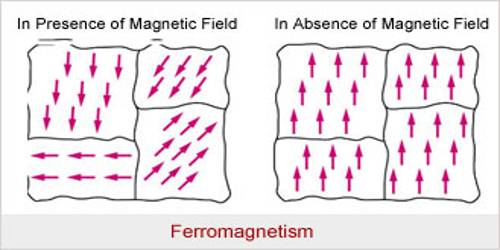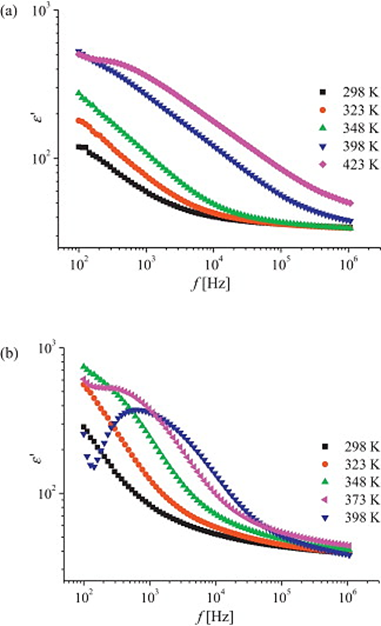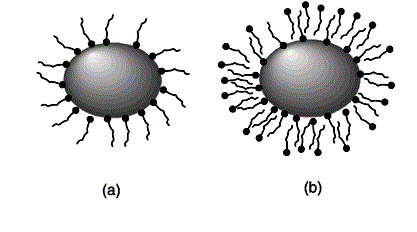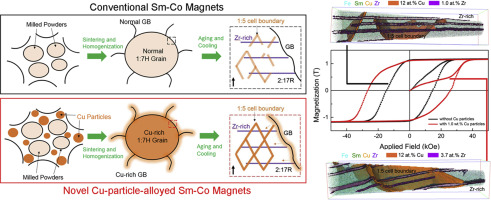Zoom to microworld - Properties
Ferromagnets
Experimentally, the properties of ferromagnets do show power law behaviour in (T − TC) provided measurements are made sufficiently close to the Curie point, but the critical exponents are somewhat different from those predicted by mean field theory. For example, ferromagnets usually show a λ-type anomaly in their specific heat at TC, rather than a stepwise discontinuity. The divergence is described by a critical exponent α ≈ 0.1, rather than zero. The residual magnetic specific heat above TC is witness to the persistence of short-range order, which is not predicted by the theory. Above TC, the susceptibility follows a power law χ ∼ (T − TC)−γ , where γ is about 1.3, whereas in mean field theory γ is 1 (the Curie–Weiss law). The critcal exponents α, β, γ , δ for nickel, for example, are 0.10, 0.42, 1.32 and 4.5, respectively.
Amorphous ferromagnets may likewise acquire a uniaxial anisotropy due to pairwise texture when annealed in a magnetic field. Similar texture can be achieved by atomic deposition of thin films in a magnetic field.
The largest values of uniaxial anisotropy are found in hexagonal and other uniaxial crystals. Smallest values are found in certain cubic alloys and amorphous ferromagnets.
In weak ferromagnets, there is also a forced volume magnetostriction in high magnetic fields, as the moment is slightly increased by additional field-induced band splitting. In ferromagnets with quenched orbital moments, it is not possible to distinguish between clockwise and anticlockwise electron motion. However, spin-orbit interaction restores an orbital moment, and leads to magnetic dichroism and Faraday or Kerr rotation.
Article src: Magnetism and Magnetic Materials, J. M. D Coey, Cambridge University Press, 2010.
Spinel ferrites
Magnetic properties of the spinel ferrites have been tailored by tuning the composition, microstructure and porosity since the 1940s when these materials first saw the light of day in the Netherlands. Mn–Zn ferrites are used up to about 1 MHz, and Ni–Zn ferrites from 1–300MHz or more. The latter have lower polarization, but higher resistivity. Conduction is usually due to traces of Fe2+, which promotes Fe2+ –Fe 3+ electron hopping. Most cations make a negative contribution to the magnetostriction and anisotropy constant; <111> directions in the spinel lattice are usually easy, unless Co2+ or Fe2+ are present.
Article src: Magnetism and Magnetic Materials, J. M. D Coey, Cambridge University Press, 2010.
Ferrrofluids
Ferrofluids have even larger susceptibilities than ionic solutions, of order 10 × 10−6 m3 kg−1, so they can be used to levitate and separate practically anything in a modest inhomogeneous magnetic field. Conversely, a magnet, which produces its own inhomogeneous magnetic field, will levitate spontaneously when placed in a beaker of ferrofluid (although ferrofluids are opaque so you are unable to see it).
Ferrofluids exhibit some weird properties. One is the peaked structure they adopt in a field applied perpendicular to the surface as they try to minimize their energy in the demagnetizing field, which becomes significant as the magnetization approaches saturation.
Article src: Magnetism and Magnetic Materials, J. M. D Coey, Cambridge University Press, 2010.
Microstructural engineering for desired properties
Ross (1985) has pointed out that it is impossible to have both high permeability materials and very low losses especially at higher frequencies. Limitations on the desireable properties at high frequencies may be more easily overcome by control of microstructure than by choice of chemistry. The choice of chemistry was made on the basis of the optimizing the intrinsic properties needed for a specific application Similarly, the microstructure of a ferrite can also be designed to optimize the features that will improve operation at the particular frequency, flux level, mode of operation and stability required in the final component or device. For example, for some applications, we may require remarkably high permeability at moderate frequencies. Other devices may require low losses at higher frequencies. The microstructures best suited for each case will be different.
Article src: Handbook of modern ferromagnetic materials, A. Goldman, B.S., Springer Science+Business Media New York, Ferrite Technology Worldwide, (1st edition), 1999.
Magnetic recording media

Img src
Instead of using the little toroids as memory elements, the equivalent can be achieved with small regions of ferrite deposited on a thin plastic tape. The particles are not toroidal, but by choice of the right material and shape the particles can store logical bits of information. The material must be capable of being magnetized in a temporarily stable magnetic state (0 or 1) so that the material must be somewhat a hard or permanent magnet material, but it should not be so hard that very high fields are needed to demagnetize or read it. Thus, the material is "semi-hard". Use is made of materials with intermediate coercive forces of several hundred oersteds. Use is also made of shape anisotropy to prevent demagnetization and to increase coercive force. The longer the particle compared to the cross section, the more the particle approaches a toroid.
Magnetic recording materials have some characteristics in common with permanent magnets in that to be useful they need to have a relatively high remanence and a sufficiently high coercivity to prevent unanticipated demagnetization resulting in the loss of information stored on the magnetic tape or disk. Magnetic recording can either be analog, as in audio recording of signals on magnetic tape or digital recording, as used in the storage of information of data on magnetic disks and tapes for computer applications.
The hysteresis loops which are desirable for magnetic recording materials are generally square loops, with high remanence, moderately high coercivity and rapid switching from one state to the other, as shown in figure, which is the hysteresis loop of a metallic magnetic recording medium. In this case the coercivity 56 kA/m and remanence 0.9 x 106 A/m are substantially higher than for γ-Fe203 particles.
Article src: Handbook of modern ferromagnetic materials, A. Goldman, B.S., Springer Science+Business Media New York, Ferrite Technology Worldwide, (1st edition), 1999.
Article src: Introduction to Magnetism and Magnetic Materials (1nd edition), David Jiles, Chapman & Hall/CRC, 1991.
Thin films
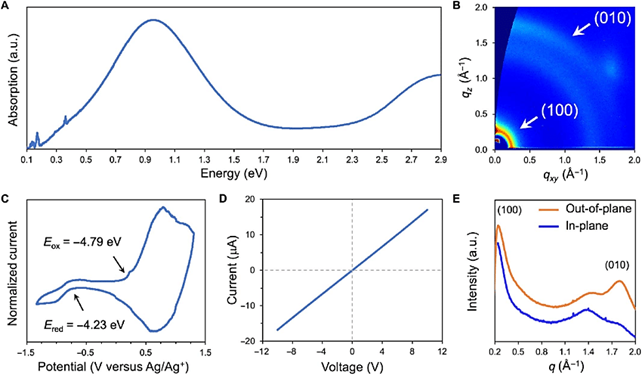
Img src
 The structure of thin films is complex and hard to characterize. The grain size of films is usually small, of the order of 1000Å or less, which is about 1/100th the grain size of most bulk materials. Since the grain size is comparable to the domain wall thickness, domain walls may extend through many grains and the domain walls lose their crystallographic identity. Preferred orientation (texture) may or may not be present, depending on deposition conditions and nature of the substrate. If a texture is present, it is a single or multiple fiber texture, with fiber axes such as <100>, <111>, etc., usually normal to the plane of the film.
The structure of thin films is complex and hard to characterize. The grain size of films is usually small, of the order of 1000Å or less, which is about 1/100th the grain size of most bulk materials. Since the grain size is comparable to the domain wall thickness, domain walls may extend through many grains and the domain walls lose their crystallographic identity. Preferred orientation (texture) may or may not be present, depending on deposition conditions and nature of the substrate. If a texture is present, it is a single or multiple fiber texture, with fiber axes such as <100>, <111>, etc., usually normal to the plane of the film.
Such a texture introduces no crystallographic anisotropy in the plane of the film. Even if it did, little magnetic anisotropy would result in the case of 80 Permalloy in which the magnetocrystalline anisotropy is close to zero. Directional structures can be produced in a film if the deposition conditions are arranged so that the direction of the incoming atoms makes an angle with respect to the film plane.
This directionality may be the result of crystallographic texture in materials with significant crystal anisotropy, or of geometrical structures produced in the film.
Article src: Ordered magnetic nanostructures: fabrication and properties, J.I. Martiın, J. Noguesb, Kai Liu, J.L. Vicent, Ivan K. Schuller, Journal of Magnetism and Magnetic Materials 256, 449–501, 2003.
Magnetic microwires

Img src
Several routes allowing the development of low-cost magnetic microwires coated by insulating, flexible, and biocompatible glass coating with tunable magnetic properties are under study. Amorphous microwires can present excellent magnetic softness, the giant magnetoimpedance (GMI) effect, and fast domain wall (DW) propagation. A high GMI effect, obtained even in as-prepared Co-rich microwires, can be further improved by appropriate heat treatment (including conventional annealing, stress-annealing, and Joule heating). Although as-prepared Fe-rich amorphous microwires exhibit a low GMI ratio, stress-annealing and combined stress-annealing followed by conventional furnace annealing allow substantial GMI ratio improvement (more than an order of magnitude). Magnetic softening and GMI effect improvement related to nanocrystallization are observed in Finemet-type Fe-rich microwires. The DW dynamics of amorphous and nanocrystalline Fe, Co, and Ni-based microwires with spontaneous and annealing-induced magnetic bistability are thoroughly analyzed, paying attention to the influence of magnetoelastic, induced, and magnetocrystalline anisotropies. Crystalline magnetic microwires can present various versatile properties, such as magnetic hardening, the giant magnetoresistance (GMR) effect or the magnetocaloric effect (MCE).
Article src: J. Phys. D: Appl. Phys. 55 (2022) 253003 (42pp) https://doi.org/10.1088/1361-6463/ac4fd7
Domain-wall pinning
The inclusion theory of domain-wall pinning was suggested by Kersten. He assumed that the magnetic domain walls move in a planar manner through the solid and that the energy of the walls is reduced when they intersect inclusions. The inclusions themselves may take many forms such as insoluble second-phase material which appears if the solubility limit has been exceeded, they may be oxides or carbides, or they may be pores, voids, cracks or other mechanical inhomogeneities. Well-known examples of magnetic inclusions are cementite (Fe3C) particles in iron and steels. Néel criticised the assumption of planar wall motion and further indicated that Kersten's interpretation ignored the fact that the magnetic free poles associated with a defect such as a void or crack would be a greater source of energy.
Hilzinger and Kronmuller shown that high coercivities can be obtained by (a) pinning of domain walls by defects and (b) elimination of domain walls by using single-domain particles. For multidomain materials the first mechanism is the most important and it is known that in many materials the most significant mechanism for pinning is the interaction between dislocations and domain walls. However, in SmCos they considered that point defects are the most important pinning sites because the domain walls in this material are so thin, being typically 30 Å in width.
Article src: Introduction to Magnetism and Magnetic Materials (1nd edition), David Jiles, Chapman & Hall/CRC, 1991.
